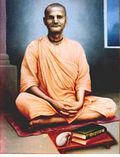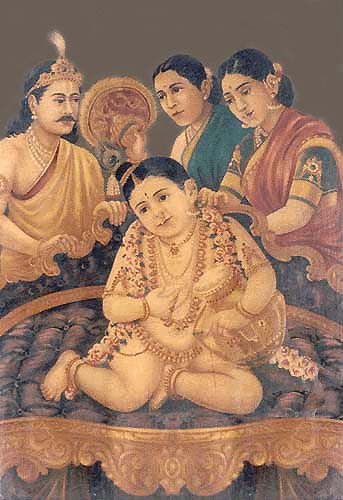

Sri Krsna-candra, Who is achintyananta-saktiman bhagavan - the Supreme Personality of Godhead and potent source of inconceivably limitless energies - allowed Mata Yasoda to bind Him with ropes to a wooden grinding mortar. By this pastime, He fully tasted the essence of her visuddha-vatsalya-prema-rasa, the totally pure spiritual mellows of her parental love. He also thereby revealed to the world the highest characteristics of His quality of bhaktadhinata, or willingness to subject Himself to the dominance of the devotee. This supremely enchanting dama-bandhana-lila was manifested on the day of Karttika-sukla pratipada - the day after the dark moon day in the month of Karttika. This is also the primary reason for the perfectly glorious month of Karttika becoming famous by the name of Damodara. Acharyapada Sri Gopala Bhatta Gosvami, the author of the Vaisnava smrti-sastra names Sri Hari-bhakti-vilasa, has outlined the devotional activities to be carried out during the month of Karttika. He indicates that the rule to be followed every day is the worship of Sri Sri Radha-Damodara and the recitation of the stotra named Sri Damodarastaka, thus (H.b.v. 16.95-96):
“O learned Vipras! If one worships the deity of Sri Radhika during the month of Karttika for the purpose of Her pleasure, then Damodara Hari becomes very satisfied. One who worships Lord Damodara by daily reciting the prayer known as Damodarastaka, which was spoken by the sage Satyavrata, verily attracts Damodara Himself.”This stotra names Sri Damodarastaka is found in the Padma-purana, being spoken by Sri Satyavrata Muni during a conversation with Sri Narada, Saunaka and other sages. Srila Sanatana Gosvamipada states in his commentary on this prayer that it is nitya-siddha (an eternally perfect prayer) that it was manifested through Sri Satyavrata Muni, and that it is actually capable of attracting Sri Damodara-Krsna. He has fully elaborated on this prayer's ability to attract Lord Damodara in his exhaustive purports, which are abounding with his own personal realisations.
For a long time, I have been contemplating a desire to publish this exposition of Damodarastaka. Especially, since upon the observance of the Damodara-vrata every year during the month of Karttika, all of us get together and sing the kirtana of Damodarastaka with united voices, at such time, this prayer is manifest in all the devotees' hearts, thereby stimulating the arising of strong desires for explanation of the verses. Many bhakta-sadhakas have specifically requested me to translate this information for them. Finally, after so many days we have published the eight Sanskrit mula-slokas of Damodarastaka along with a Sanskrit anvaya (word for word synonyms), and Srila Sanatana Gosvamipada's Sanskrit tika named Dig-Darsini. For the benefit of readers who do not know Sanskrit, we have also included Bengali translations of the mula-slokas and Srila Sanatana Gosvami's commentary.
In the present age many so-called intellectuals, who are provoked and irritated by Kali-yuga's degradation, cast an extremely contemptuous glance upon the usage of the Sanskrit language. In spite of this, I have still published this book on Damodarastaka out of a desire for the benefit of people living in all lands. It is good if the literary scholars of the Bengali language would keep in mind that, above all else, our development of Bengali is wholly dependent on its derivation from the Sanskrit language. It is inevitable that the advancement of Bengali proceeds side-by-side with the advancement of Sanskrit literatures. Those who attempt to develop Bengali by jumping over Sanskrit literatures end up thoroughly steeped in gross error. We have taken note of the language produced by scholars of this type - it is disorderly and haphazard in all ways. Bengali is always subordinate to and dependent on Sanskrit; namely, it is not that Bengali is an independent language and Sanskrit is completely different. The fact is that Bengali is paratantra (totally dependent) and Sanskrit is svatantra (totally independent). Keeping this precept in mind, we have placed this book before the assembly of learned sages.
This astaka written by Srila Vyasadeva is an ideal specimen amongst the world of literature due to its philosophical conclusions, its expertise of composition, and its astonishing excellence in revealing the essence of the Lord's lila. By composing his tika named Dig-Darsini with such clear and elaborate details, Jagad-guru Srila Sanatana Gosvamipada has fully explained the comparative differences of various mellows within the kingdom of sadhana. By that he has proven in all respects the superiority of the vatsalya-rasa and madhura-rasa.
“And finally, at the conclusion of the prayer, the author desires to describe the supreme superexcellence of the rasa-lila and other transcendental pastimes that Lord Sri Krsna performs with Sri Radhika, but since these are the topmost of confidential topics, they are not mentioned directly. The logic of madhurena-samapayet - 'all undertakings should be completed sweetly' - applies here. Therefore such confidential pastimes are referred to by a mere hint only, as they are offered obeisances in the words namo nanta-lilaya (my obeisances unto Your limitless pastimes).”Because the sahajiyas are unfit to taste the rasa-lila, it is not possible to count them amongst the exalted worthy devotees. All we know is - bhakti is transcendental to the three worlds. It cannot be brought into the realm of analysis or discussion that is confirmed to the three worlds. They think that matter can somehow become cit (spiritually conscious), and that by the power of one's sadhana it is possible to see Bhagavan with one's physical eyes -this is the opinion of the prakrta-sahajiyas. They say that just as bell-metal turns into gold when mercury is added to it, similarly the material body (prakrta) becomes transcendental (aprakrta) by the power of performing bhajana. They say that at such a time, one obtains the darsana of Bhagavan with one's eyes. Srila Sanatana Gosvami has thoroughly refuted these claims of the prakrta-sahajiyas in his book named Brhad Bhagavatamrta, as well as in his commentary of Sri Damodarastaka named Dig-Darsini
I would like to quote from a small article written by our Srila Thakura Bhaktivinoda on the topic of Karttika-vrata. In this article, he has clearly ascertained the days on which the conclusion of the vrata is observed. The rule is - devotees who begin their vrata on the ekadasi day also conclude it on the last ekadasi. Similarly, those who begin on the dvadasi or the purnima also end on their corresponding days. Bhaktivinoda's article states:
The observance of the Karttika-vrata is one of the most important things for the Vaisnavas.
In accordance with these words, the vrata therefore begins on the waxing ekadasi that comes the day after Vijaya-dasami in the month of Asvina. And the vrata will be concluded on Utthana-ekadasi. That vrata which is observed during the month between these two dates is called niyama-seva. The rules of niyama-seva are: every day during this month, one must rise upon the last hour of the night, purify oneself and perform the mangala-arati of Sri Krsna. Then, after bathing in the morning, one should worship Lord Damodara. At night, one should light brilliant lamps filled with either ghee or sesame-seed oil, and place them in these places - in the Lord's temple, around the base of tulasi plants, and in the sky. During the month of Karttika, one should eat only vegetarian foodstuffs and Bhagavan's prasad remnants. One should renounce excessive eating and sleeping, plus avoid using oil, wine, and bell-metal utensils. After honouring prasad, one should hear or recite scriptures headed by Srimad Bhagavatam in the company of Vaisnavas. There should be incessant harinama-kirtana and smarana. Thus passing the entire month in observance of such regulations, on the final Utthana-ekadasi day one should fast from everything including water and stay awake all night absorbed in Krsna-katha. On the next day, after first purifying oneself and engaging in hari-kirtana, one should serve the Lord's prasad to one's dearmost intimate Vaisnava associates, and when they are finished one may then honour prasad. That day, at the end of the night, the vrata will be completed.
The chief aim of observing this Urjja-vrata is to please Sri Radha-Damodara. Srimati Radharani is called Urjjesvari (the Queen of the Urjja-vrata). Only because of this, in order to establish the pleasure of Sri Sri Radha-Damodara, the sage Satyavrata Muni uttered (in the eight verse of Damodarastaka) the words namo radhikayai tvadiya priyayai - “My obeisances unto Radhika, You most beloved.” By this statement, he indicated that the sole activity to be done during the observance of Damodara-vrata is the worship of Sri Sri Radha-Damodara.
Among the 64 branches of bhakti followed by our Gaudiya Vaisnavas, we see that the observance of Urjja is listed. It is to be understood that one follows the Catur-masya-vrata completely only if one honours Urjja during it. Some devotees are of the opinion - “Because Catur-masya-vrata is not listed among the 64 branches of devotion, we will only follow the (one-month long) vow of Urjja; we will not undergo the difficulty of observing the entire four-month-long vow.” In this way, those persons who attempt performing bhajana, but who are unaware of the deep meaning of the sastras, thereby remain in the indulgences of in discipline. Sriman Mahaprabhu Himself observed the Catur-masya-vrata while situated in many different places, and has thereby taught the practice by His own example. We cannot consider such persons, who are unable to follow the instructions that were enacted and preached by Mahaprabhu, to be part of the lineage of pure Vaisnavas.
At this point, we would like to mention that the principle of atma-nivedana is listed as one of the nine types of devotion (which are counted among the six types of surrender, saranagati). Is it understood, then, that by performing atma-nivedana (offering one's soul), the other five types of surrender are therefore unnecessary? The ultimate surrender among the six processes of saranagati is atma-nivedana - by this being listed as such, it is understood that engaging in the other forms of surrender are also recommended for the sadhaka. Thus it is accepted that a single sadhana takes the form of several different aspects.
Due to the eternal nature of Sri Sri Damodarastaka, it is necessary to study it every day not only during the month of Karttika (or Damodara), but also during the entire four-month period of Catur-masya. And what's more, it is actually fit to be studied every day of every month, year after year. Upon the pure chanting of Damodarastaka, Lord Damodara Himself becomes very pleased - for this objective, I have especially compiled this volume with great care and attention.
During the period when Gosvamipada was composing his tika, he quoted some conclusions already written in his own Brhad Bhagavatamrta. We have added these verses in the form of footnotes. They are printed with their mula-slokas along with explicit Bengali translations to facilitate the understanding of the readers.
In conclusion, it is my earnest prayer before the suddha-vaisnavas: that they study this book during Catur-masya or Urjja-vrata and attain priti (the pleasure of the Lord) - then only will I consider my labour fulfilled. This book makes it possible for them to easily gather so many truths; for that reason, I have made such a humble request.
Verse 1
namamisvaram sac-cid-ananda-rupam
lasat-kundalam gokule bhrajamanam
yasoda-bhiyolukalad-dhavamanam
paramrstam atyantato drutya gopya“I bow down to the supreme controller, Sri Damodara, whose form is the embodiment of eternity, knowledge, and bliss. His glistening earrings swing playfully to and fro upon His cheeks. He manifests super-excellent pastimes in Gokula, by stealing fresh butter suspended from the rafters of the gopi’s storerooms. In fear of Mother Yasoda, He jumps down from a wooden grinding mortar and quickly runs away. She runs swiftly after Him and finally catches Him from behind.”
Verse 2
rudantam muhur netra-yugmam mrjantam
karambhoja-yugmena satanka-netram
muhuh svasa-kampa-tri-rekhanka-kantha-
sthita-graivam damodaram bhakti-baddham“He cries and rubs His eyes again and again with His two lotus hands. His eyes are fearful and His breathing quick. As Mother Yasoda binds His belly with ropes, He shivers in fright and the pearl necklace shakes upon His neck, which is marked with three lines like a conch shell. To the Supremem Lord, Sri Damodara, whose belly is bound by His mother’s pure love, not by rope, I offer my humble obeisances.”
Verse 3
itidrk-sva-lilabhir ananda-kunde
sva-ghosam nimajjantam akhyapayantam
tadiyesita-jnesu bhaktair jitatvam
punah prematas tam satavrtti vande“O my Lord, by Your own childhood pastimes, You continually immerse the residents of Gokula in pools of ecstasy. You reveal to those who are attracted to Your majesty and opulence, that You are only conquered by the love of Your pure devotees. Again I offer my obeisances with love and devotion hundreds and hundreds of times.”
Verse 4
varam deva moksam na moksavadhim va
na canyam vrne ‘ham varesasd apiha
idam te vapur natha gopala-balam
sada me manasy avirastam kim anyaih“O Lord Damodara, although You are able to give all kinds of benedictions, I do not pray to You for liberation, nor the supreme goal of eternal life in Vaikuntha, nor for any other boon. My only desire, O Lord, is that Your form as Bala Gopala in Vrindavana may constantly remain in my heart. I have no use for any other boon besides this.”
Verse 5
idam te mukhambhojam atyanta-nilair-
vrtam kuntalaih snigdha-raktais ca gopya
muhus cumbitam bimba-raktadharam me
manasy avirastam alam laksa-labhaih“Your supremely enchanting face, encircled by shining locks of dark blue curling hair, resembles the fully blossomed lotus, tinged with a reddish luster, due to being kissed again and again by Mother Yasoda. May this vision of Your lotus face, with lips are red as bimba fruit, remain forever in my heart. Millions of other benedictions are of no benefit to me.”
Verse 6
namo deva damodarananta visno
prasida prabho duhkha-jalabdhi-magnam
krpa-drsti-vrstyati-dinam batanu-
grhanesa mam ajnam edhy aksi-drsyah“O Damodara! O Lord of divine beauty and unlimited mercy! O all pervading Visnu! I offer my obeisances unto You. May You be pleased with me. I am drowning in an ocean of sorrow and feeling almost dead. Shower Your nectar laden glances upon me, thereby uplifting me and enthusing me with life. Please accept me, O Lord, and become visible before my eyes.”
Verse 7
kuveratmajau baddha-murtyaiva yad-vat
tvaya mocitau bhakti-bhajau krtau ca
tatha prema-bhaktim svakam me prayaccha
na mokse graho me ‘sti damodareha“O Lord Damodara, although Mother Yasoda bound Your divine form to a wooden grinding mortar, You mercifully delivered the sons of Kuvera, Manigriva and Nalakuvara, who were cursed to stand as trees, and You gave them the gift of devotional service. Please bless me in this same way with Your most wonderful prema-bhakti. I have no eagerness for any other type of liberation.”
Verse 8
names te ‘stu damne sphurad dipti-dhamne
tvadiyodarayatha visvasya dhamne
namo radhikayai tvadiya priyayai
namo ‘nanta-lilaya devaya tubhyam“O Lord, I offer respectful obeisances unto Your belly, the abode of the entire universe, which is bound by Mother Yasoda with a brilliantly effulgent rope. To this rope I offer my humble obeisances. I offer repeated obeisances to Your dearmost beloved Srimati Radharani, and I bow before You, who are performing unlimited super-excellent pastimes.”
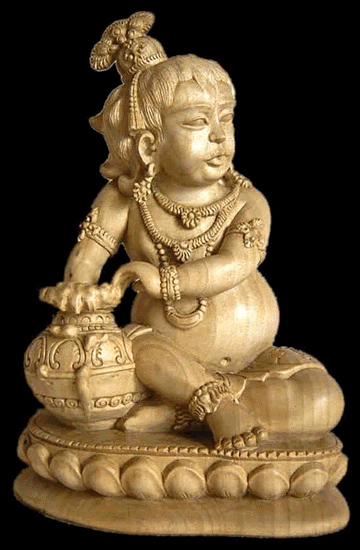
namamisvaram sac-cid-ananda-rupam
I offer my respectful obeisances unto that Supreme LordSri Sri Damodarastakam - Text 1
lasat-kundalam gokule bhrajamanam
yasoda-bhiyolukalad-dhavamanam
paramrstam atyam tato drutya gopya
Whose form is composed of eternity, knowledge and bliss
Whose earrings swing and play upon His cheeks
Who is splendrously manifest in Gokula
Who is very fearful of mother Yasoda,
and jumping down from the wooden grinding mortar quickly runs away
Who is chased by Yasoda running very quickly after Him
and is ultimately caught from behind
In the beginning of the mula-sloka, the very first intention is expressed by the word namami - “I bow down.” Obeisances are thus offered with love and devotion before commencing the description of the Lord's specific characteristics of excellence that are exhibited by His tattva, rupa, lila, guna and so forth. Also mentioned is the essence of His own divine supremacy as the Supreme Personality of Godhead manifested in Gokula, and also His distinctive features as the origin of all. Furthermore, the word namami is indicative of an auspicious invocation (mangalartham). At the start of all functions it is customary to offer respects to isvara which express an attitude of devotional service unto the Lord. For this reason, obeisances are offered first unto the Lord in this verse.
(Now the commentator, Sri Srila Sanatana Gosvami examines tattva-visesa or the excellence of the Lord's truth:) Obeisances unto whom? Unto Isvara, the supreme controller. Namely - He who is (1) sarva-saktimanta (endowed with all potencies), (2) jagat-ekanatha (the only Lord of the universe) and (3) nija-prabhu (my own Master). In the first instance He is addressed as such in order to obtain the power of sakti needed to offer the prayer, in the second instance, He is addressed as such to indicate that He is the one and only Lord Who is praiseworthy; in the final instance, He is addressed as such to signify the specific nature of bhakti or devotion. How is He manifest? As sac-cid-ananda-rupam or a form composed of compressed clouds of eternity, knowledge and bliss. This is the statement of His supreme sovereignty in regards to His tattva-visesa attribute or excellence of truth.
(Now rupa-visesa, the excellence of His beauty is described:) His distinct excellence of beauty is illustrated as follows: lasanti (the swinging of His earrings) was manifested when He ran away in fear of Sri Yasoda; or also, His earrings sport upon His cheeks as a result of His continuously playing in the transcendental pastimes of childhood. Thus, His divinely splendrous face is especially portrayed. Or also, yet another meaning of lasat-kundalam is - due to the maha-saubhagya or great fortune of personally kissing His divine cheeks, these earrings have attained a position of superexcellence above all His other ornaments. And this superexcellence also indicates the fortune of the other ornaments adorning His various limbs. Furthermore, lasanti indicates that these earrings are glistening because they are enriched with the splendrous effulgence of the Lord's bodily complexion; therefore Krsna's body is the ornament of His ornaments. This is the meaning. Consequently, it is stated by the gopis in the Tenth Canto (Bhag. 10.29.40):
“O Sri Krsna! By seeing Your beauty, which attracts the three worlds, these cows, birds, trees and deer are all experiencing their hairs standing on end!” (“What is the wonder, then, if we are also bewildered?”)
In the Third Canto (Bhag. 3.2.12), it is also stated by Sri Uddhava to Vidura regarding Sri Krsna's beauty:
“Sri Krsna's beauty is so enchanting that it even astonishes Himself: that beauty represents the supreme zenith of great opulence, so much so that He is actually the ornament of His ornaments.”
Now the parivara-visesa or attributes of His family portray His unique excellence. The word gokule indicates that place where gopas, gopis, cows, calves and so forth reside. The word bhrajamanam indicates a particularly befitting place wherein He can manifest an excellence that surpasses that of previous lilas. Moreover, He is splendrous because only in Gokula does He manifest His svabhavika-sobha, or most natural characteristics of brilliance. It is stated in the Tenth Canto (Bhag. 10.32.14):
“(Bhagavan Sri Krsna, Who sits upon the asana formed in the lotus-like hearts of the siddha-yogis...) Manifesting a body that is the abode of all the splendour of the three worlds, He sat upon the asana presented by the gopis, was worshipped by them, and thereby radiated even more splendour.”
His excellence of lila-visesa, or attributes of His pastimes, are stated in the last two lines of the verse. The word yasoda indicates yasodaya, or “From His mother Yasoda”. Bhiya indicates the fear of being punished for His offense of breaking the yoghurt pots, stealing fresh butter and so forth. Ulukhalat denotes “from the mortar” - in order to steal the fresh butter suspended from the rafters, He took a large wooden grinding mortar that was kept in the same storeroom, turned it on end, and climbed up on it; but (spotting His mother coming into the room with a stick in her hand) He immediately gets down again. Dhavamanam - He speedily runs away. In this regard, if one desires to know the particulars of this pastime, it can be found in the Tenth Canto (Bhag. 10.9.8-9) thus:
“Then Sri Krsna turned the grinding mortar on end, climbed up on it and began distributing the fresh butter hanging from the rafters to the monkeys as freely as He liked. Due to knowledge of His own mischievous thievery, His eyes fearfully darted this way and that. Mother Yasoda saw Him doing this and slowly crept up from behind to catch Him; but He noticed Her coming with a stick in her hand, and He quickly got down from the mortar and started running away, just like a person stricken with fear. Even though highly advanced yogis are enabled by the strength of their penances to merge their minds with brahma, still they cannot get a glimpse of this scene - of Yasoda-devi chasing her son Krsna from behind while attempting to catch Him.”
Then, tato-drutya - she ran very swiftly. Due to the samasa conjunction, these two words become one. Gopya - by Sri Yasoda, para amrstam - catching hold of His back. Here the words atyanta tato drutya (running behind Krsna very swiftly) imply the saundarya-visesa (excellence of beauty) of Yasoda's full breasts, broad hips and so on, as well as the particulars of her affection for her son. The loving use of the word gopya connotes the grand fortune that came upon the gopa caste (by Krsna preferring to appear among them). By the word paramrstam (caught by His back), the unique attribute of superexcellent affection that Bhagavan Sri Krsna feels for Yasoda-mata (sneha-visesa) is intimated. In this regard also, one may search out the following verse from the Tenth Canto (Bhag. 10.9.10):
“While chasing after Krsna, the slim waisted Yasoda's broad hips caused her pace to slow down. From running quickly, the flowers had come loose from her hair and were falling after her, but she still continued to pursue Him. In this fashion, after chasing and chasing Him, she finally caught Him from behind.”
Intro-if one neglects to perform the Kartika Vrata all his pious merits amassed in the passed are burned to ashes; his study of the Vedas becomes futile; and his performance of japa, charity, and austerity becomes fruitless.
Glories of Kartika Vrata-Kartik is the best, the purest of purifiers, and most glorious of all months. Kartika month is particularly dear to Lord Sri Krsna. This month is full of bhakta vatsalya. Any vrata, even the smallest, will yield huge results. The effect of performing a Kartika Vrata lasts for one hundred lifetimes, whereas ordinary vratas only last for one lifetime! As Krsna says in Gita that He is the month of Nov-Dev, similarly, Srimati Radhika is the holy month of Kartik which precedes His month. Rupa Gosvami and others refer to Radharani as the Kartika-devata or Kartika Devi, in other words, Radhika is the goddess or presiding Deity of the Kartika Vrata.
Daily Offer-tulsi arotik, ghee lamp to Krsna and sing Damodarastakam, bathe in Yamuna if possible, give charity to pure devotees.
Dont Eat: grains given by others, honey, sesame seeds, oils, hing, eggplant, loki, tasty foods like sweets and fried foods, samosas, pakoras.
Dont Do: cut hair, nails, use things of others, criticize Vaisnavas, Vedas or anyone, no oil on body, do not find faults in others or be envious.
Prayer before beginning: "O gopikas! By your mercy may Radha and Krsna be pleased with my Kartika Vrata."
Benefits Observing Kartik Vrata: All sins flee from the heart. Perform other vratas one hundred times not equal to one performance of Kartik Vrata. All the holy places will live within your body. Proper performance of Kartik Vrata gives one a million times the result of chanting mantras, do yatras and other types of vratas. Those who worship Damodara in Vrndavana even once easily attain Krsna bhakti. Dhruva Maharaja attained Hari darsana by worshiping Krsna in Mathura during the Kartika month.
Srila Prabhupada on When to Start Kartika Vrata: "In Vrndavana we should have Kartika Vrata, Urja Vrata, for one month beginning on Ekadasi (Pasanukusa) (Srila Prabhupada Tape 10/6/72)
Pasanukusa Ekadasi Morning: Offer prayer-"O Janardana, O Damodara, O Devesa who are accompanied by Radhika. During the month of Kartika, I will bathe early every morning for Your satisfaction."
1. Rise early every day by Brahma Muhurta, bathe, chant japa offer Mangala Arotik
2. Hear Srimad Bhagavatam, especially Radha and Krsna pastimes in Vrndavana, daily in association of exalted Vaisnavas, if possible. By regularly reading Srimad Bhagavatam during Kartika month, one gets the benefit of reading all the eighteen 18 Puranas. All other duties should be given up in favor of hearing the scriptures from sadhus during this month.
3. Chant continually in japa and kirtan, Krsna nama, do extra rounds and more kirtana with family.
Eat your meals only on palasa leaves (if possible, will give tremendous punya.)
No oil on body and NO EATING honey, eggplant, portal, pickles, red rajma beans, or sesame seeds, or urad dahl (no kichoris)
Daily sing the Damodarastakam, meditating on meaning
Daily offer a ghee lamp to Krsna Deity or photo (no need of picture of Mother Yasoda-Damodara or photo)
Daily offer arotik and prayers to Tulsi devi praying for eternal residence in Vrndavana and eternal service of the lotus feet of Radha and Krsna.
Daily chant the Radha-krpa katakasam, and Krsna krpa kataksam in Giti Guccha songbook
Also chant other prayers to Radha and Radha Krsna Yugala from the Giti Guccha songbook
ON Ekadasi, Dvadasis, and Purnima chant the one-thousand names of Radha
On the three Ekadasis in Kartik try to observe Nirjala Vrata and stay awake chanting hari nam, especially on the last one, Uttana Ekadasi, when Lord Visnu and all the demigods awake after four months slumber.
Donate Charity to Pure Devotees
Offer special nice foods to Krsna for entire month. For example every day make sweet rice, (khira) which is the favorite food of Krsna.
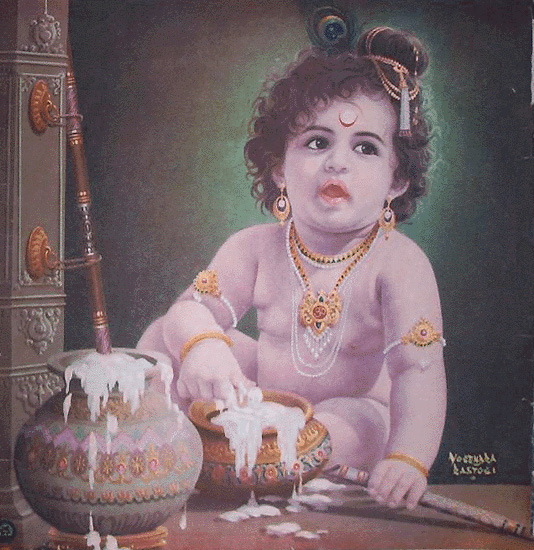
rudantam muhur netra-yugmam mrjantam
(Afraid of the stick in His mother's hand)Sri Sri Damodarastakam - Text 2
karambhoja-yugmena satanka-netram
muhuh svasa-kampa-tri-rekhanka-kantha-
sthita-graiva damodaram bhakti-baddham
Who cries again and again and rubs His eyes with both His lotus-like hands
Whose eyes express extreme fearfulness
Who sobs again and again with quick breathing making the necklaces upon His three-lined neck quiver
Whose belly is bound only by His mother's devotion.
Unto this Damodara I offer my humble obeisances
“(Mata Yasoda saw that) The mischievous child then cried and cried while rubbing His eyes with His hands, thereby smearing the dark eye-lining cosmetics from them. (Krsna saw the stick in her hands, and) His eyes became overwhelmed with fright. In this condition, Yasoda seized His hand and proceeded to chastise Him in order to instil fear in Him.”
The details of this pastime are now spoken of in the second verse beginning with rudantam. Seeing the whipping stick in His mother's hand, and apprehending being struck with it, He behaved as if terrified so that she would see His distress and think “He is afraid of being punished”. He hoped that by her seeing this attitude of His, she would not hit Him with the stick. Thinking in this way (that He would be spared punishment), therefore karambhoja-yugmena netra-yugmam mrjantam - He rubbed both eyes again and again with both of His lotus-like hands at the same time. This is a natural characteristic of balya-lila, and indeed the normal habit of small children.
Or else, karambhoja-yugmena netra-yugmam mrjantam may also indicate that by the influence of His fright, many tears were actually forming in His eyes; therefore He rubbed them again and again in order to make the tears fall out. Or furthermore, He rubbed His eyes again and again in order to wipe away the tears that were falling again and again; this is yet another meaning. Now satanka-netram - dreading His mother's punishment, His eyes expressed how much He was terrified in His mind. Or else, it refers to His glancing this way and that in extreme fear. In this regard also, He tries to avoid being punished; thus another confidential pastime is disclosed.
Moreover, muhuh svasena - due to His crying and sobbing again and again, kampat - trembling, tri-rekhanka - marked with three lines just like a conchshell, kanthe stitham graivam - all His neck ornaments like pearl necklaces and so forth - He who appears this way. Damodaram - Whose belly is tied with a rope. He is described thus in the Bhagavatam (10.9.14):
“Just as an ordinary mother binds her naughty son, Yasoda Mata considered Sri Krsna to be her own ordinary child and tied Him to the grinding mortar with a rope.”
In stating that knots were tied on the rope both to His belly and to the mortar, this indicates the particulars of Sri Krsna's excellence called bhakta-vasyata, or His quality of coming under the control of His devotees. Bhaktyaiva baddham - this refers to He Who responds only to bhakti in the following two ways: from His mother's viewpoint, He is bound by the loving parental devotion she feels for her son; from His viewpoint, He is bound by His mother's devotion in the form of bhakta-vasyata. Baddham - He willingly accepted the binding, although no rope had the power to bind Him. Thus mother Yasoda eventually collected all the ropes in her household, but upon tying them together the length still came out two fingers too short to fit around His waist. This is described in the following slokas from the Bhagavatam (10.9.15-17):
“While tying up the naughty child, the rope came out two fingers short, so Yasoda Mata tied another length to it. This rope also came out two fingers short, so she tied yet another length to that one; but no matter how many ropes she added, it always ended up too short. Thus she was unable to bind Him, even by combining all the ropes in the house. (Then her gopi friends began to smile and she herself also smiled and laughed in astonishment).”
Or furthermore, the reason for this characteristic of the rope around His waist is: bhaktyaiva baddham - He can be bound only by devotion and nothing else. By this He becomes controlled. Such is certainly the conclusion of the aforementioned description. In this connection, it is further stated in the Bhagavatam (10.9.18-21):
“While attempting to bind Krsna) Yasoda became fatigued from tying so many ropes together again and again, and she perspired as the flower garlands in her hair fell loose. Then the young child Sri Krsna saw her weariness and mercifully consented to being tied up. O Maharaja Pariksit! Although He controls the entire universe along with its highly qualified demigods, the supreme independent Hari thus displayed how He comes under the control of His devotees. Therefore this gopi Yasoda Mata received such a great benediction from He Who awards liberation - a favour not granted to Lord Brahma, Mahesvara or even Laksmi Devi herself, who sports as half the body of all the Lord's incarnations. Bhagavan Gopika-suta, the Supreme Lord appearing as the son of a cowherd woman, is thus readily available for His devotees, yet remains far away from those absorbed in the bodily concept of the eight fold yoga practices as well as those focusing on visions of the Self through intellectual pursuits.” (In other words, the tapasvis and the jnanis embark on a very difficult path of spiritual searching, but - being completely unable to attain Bhagavan - at best can end up realising only a minute fraction of Lord Krsna's true glory”.
These verses from the Bhagavatam indicate direct proof of all such conclusions. Elsewhere in the Bhagavatam it is stated (10.10.25):
“Because Devarsi Narada is My dear devotee, and because these two boys are the sons of My devotee Kuvera, I will deliver them in order to fulfil the words previously spoken by Mahatma Narada.”
The purport of these words spoken by Sri Krsna is that He totally depends on the devotion of Sri Narada; (being pleased with Narada's bhakti) Krsna therefore dragged the grinding mortar and broke down the two trees in which the cursed brothers stood. This is why the Lord performs these and indeed all other pastimes (because of the devotion of His devotees).
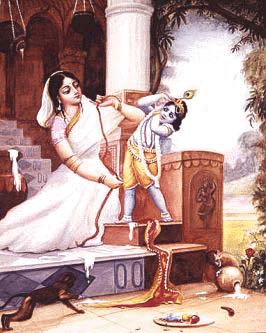
Sri Sri Damodarastakam - Text 3itidrk sva-lilabhir ananda-kunde
sva-ghosam nimajjantam akhyapayantam
tadiyesita-jnesu bhaktair jitatvam
punah prematas tam satavrtti vandeIn this way, to He Who perpetually drowns the residents of Gokula in pools of pure bliss Who informs those devotees desirous of knowing His supreme opulence and majesty that He is naturally conquered only by His loving devotees I again offer my obeisances with love unto that lord Damodara hundreds and hundreds of times
"If you dance, then we will give you a sweet' - by these words, or by clapping their hands, the elder gopis sometimes induced Sri Krsna to dance. Thus Bhagavan, the Supreme Personality of Godhead, danced just like an ordinary child. Sometimes they made Him sing, and He therefore sang just like a bewildered innocent boy. In this way, He came under the control of the cowherd women exactly like a wooden puppet on strings. Sometimes His relatives would order Him to bring their shoes, chair or measuring pot; but if He was unable to lift the article called for, He would grasp it firmly and, just to please His dear relatives, flap His elbows again and again to demonstrate His childish strength.”
On the basis of these conclusions of the Bhagavatam, it is further stated - sva-ghosam means all the living beings dwelling in Gokula - ananda-kunde nimajjantam - He immersed them in a deep pool brimming with liquid bliss mellows (ananda-rasa-maya-gabhira-jala). Therefore it is declared in the Bhagavatam verse quoted above: svanam pritim samudvahan - by these actions, He stimulated the complete love of His own dearmost relatives (priti). And furthermore, the word ghosah additionally means “the loud proclamation of His glories.” Similarly, the word sva also connotes either svasya or svanam - that either His own glory or the glory of the gopas and gopis is proclaimed by these pastimes. In this mood He personally drowned them all in pools of bliss (ananda-kunde nimajjantam) - and they experienced a very special excellence of supreme happiness (parama-sukha).
"And furthermore, it is especially noted that - tadiyesita-jnesu - unto those who are attached to knowledge of the Lord's majestic opulence (aisvarya), and who worship Him accordingly, He declares bhaktair jitatvam - only in front of His own pure devotees does He become totally submissive, being conquered by their loving devotion; akhyapayantam - He has fully displayed this quality for all to see. The meaning is - “I willingly become submissive to the control of My servants who are attached to bhakti, but I will never submit Myself to those fond of jnana.” This is confirmed in the Bhagavatam (10.11.9) thus:
"Bhagavan Sri Krsna has proclaimed to the bhaktas of the universe who are fond of aisvarya-jnana that He is fully submissive only to His own pure devotees.”
"The meaning of this Bhagavatam verse is - the word tad-vidam indicates devotees who are attached to bhagavad-aisvarya-jnana. Or yet another meaning is - tadiyanam suggests that He displays this quality (of submission to His devotees) only in front of those who are already aware of the prabhava or power of His most dear, favourite devotees; He does not exhibit this feature to others. The reason for such behaviour is - those who are unaware of the special glories of the Vaisnavas, and those who cultivate kevala-jnana (impersonal knowledge) are unqualified to be presented with a display of the supremely confidential truth regarding devotion and the glories of devotion. In this mood, a further meaning of tad-vidam (from the Bhagavatam verse 10.11.9 quoted above) is - this word reveals bhrtya-vasyata-vidam, or those who are unaware of Sri Krsna's quality of submitting to His devotees. Now (in Damodarastakam) the word prematah denotes “with an excellence of love and devotion”; satavrtti means hundreds and hundreds of times; tam - unto that isvara - punah vande - I repeatedly offer my respectful obeisances. Therefore the only thing worshipful for me is to offer my obeisances unto the superexcellence of the process of bhakti, which brings the Supreme Lord under the control of His devotees. Such a condition can never come about through aisvarya-jnana, or knowledge of His divine majesty. This alone is the mood of the devotee offering this specific prayer.
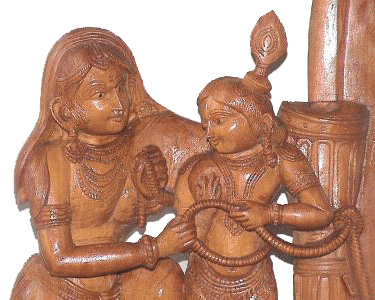
varam deva! moksam na moksavadhim va
He Deva!Sri Sri Damodarastakam - Text 4
na canyam vrne 'ham varesad apiha
idam te vapur natha! gopala-balam
sada me manasy avirastam kim anyaih
O Lord! Although You are capable of granting any boon I do not pray to You for liberation,
nor for eternal life in Vaikuntha, or for any other benediction
He Natha! O Lord! May Your form as a cowherd child forever remain manifest in my heart
Other than this I have no need of anything
Specifically, I do not pray for moksa, the fourth purusartha or goal of human life (to achieve freedom from material contact by merging into the brahman effulgence); nor do I pray for moksaya-avadhim, the highest supreme zenith of liberation in the form of eternally living in Sri Vaikuntha-loka, where the excellence of life is the nature of thickly condensed happiness; nor do I pray for anyan ca - other things such as the nine methods of devotional service headed by sravana (hearing, chanting, etc.) - I do not desire the boons that may be obtained by any of these processes. Furthermore - even if You want to give them to me, and additionally - even if others consider such things to be very appealing - iha, here in Vrndavana I do not have the slightest desire for them. This word iha can also be used in relation to the statements of the rest of the verse. It is naturally understood that the three benedictions referred to - moksa (liberation), moksavadhi (the highest zenith of liberation) and anya (other things) - all reflect an ascending level of superiority, each being greater than the last. In this regard, the superiority of Vaikuntha to impersonal liberation is clearly described in my (Srila Sanatana Gosvami's) Brhad Bhagavatamrta, Uttara Khanda 1.14-15 *please see Appendix A, page 23*. And the superiority of the nine process of devotion (headed by sravana) to Vaikuntha-loka is described in the Bhagavatam (3.15.49) thus:
“(The Four Kumaras headed by Sanat, after cursing the disrespectful devotees named Jaya and Vijaya, said to Lord Visnu Who had just appeared:) Oh Lord, we pray that you let us be born in any hellish condition of life, as long as our ears are always filled with the chanting of Your transcendental qualities.”
By these words, it becomes evident that the nine processes of devotion beginning with sravana can be perfected even while living in hell - wherever one is, and in whatever condition of life, one thereby experiences the perfection of living in the eternal abode of Vaikuntha.
This being the case, then what boon does one want from the Lord? The answer is given in this fourth verse of Damodarastakam: he natha! - iha idam te vapur gopala-balam - O Lord! This form of Yours as a cowherd child in Vrndavana - sada me manasi avirastam - may such a form ever be manifest in my mind. Since He is antaryami, situated as the indwelling Supersoul, He may be seen manifesting the divine beauty of His every limb within one's heart, just as clearly as one sees directly with the eyes.
Still - (even if Krsna were to personally address the devotee and offer:) “O he! The above-mentioned three kinds of boons beginning with moksa are not ordinary; they are most desirous, and anyone would immediately accept them...would you accept them?” The answer is given herein - kim anyaih - “What is the use of all these things? They have no value to me.” This is the meaning. The reason behind this attitude is - Sri Krsna is composed of all the bliss in the universe, so if He is attained then everything else is automatically and perfectly attained. But if one cannot attain Krsna, then the imperfection perceived in the absence of the desired goal especially creates a grand distaste and lamentable misery at the mere thought of attaining something of lesser value. Therefore it is said here that other boons are useless - kim anyaih - “What good are they?” This is the mood.
Or else, the words kim anyaih show yet another meaning. (Again the Lord may ask) “Even though you do not pray for the boons beginning with moksam, would you care then for the boon of directly seeing and conversing with My supremely worshipable four-armed form (of Sri Narayana and other aisvarya-maya-murtis)?” The answer remains the same - kim anyaih - “Other boons are useless to me.” The intention behind this is - “If Your divine form of a cowherd child (which is the crest-jewel of all splendours) would always be manifest in my heart, then I would feel very, very pleased; nothing short of that would satisfy me.” This is the mood.
For further details regarding the glories of antar-darsana (seeing the Lord within the heart), please see Brhad Bhagavatamrta, Uttara-Khanda 2.86-96 *please see Appendix B, page 24.*. Therein the sage Sri Pippalayana on the planet Tapoloka has explained all these principles very elaborately. Now the Damodarastaka prayer offered by Satyavrata Muni similarly demonstrates that the longing for inner darsana is the best goal of all - from this prayer all these things can be clearly understood.
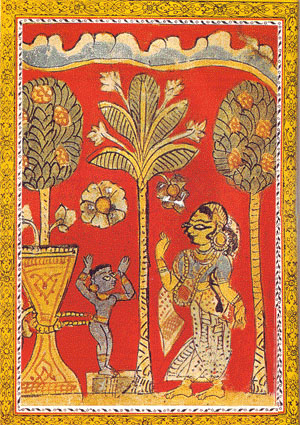
idam te mukhambhojam avyakta-nilair
O Lord! Your lotus like face is completely surrounded by very dark blue, glossy reddish-Sri Sri Damodarastakam - Text 5
vrtam kuntalaih nigdha-raktais ca gopya
muhus cumbitam bimba-raktadharam me
manasy avirastam alam laksa-labhaih
tinted curling hair and is kissed again and again by mother Yasoda
Your lotus face is endowed with lips red as bimba fruits - may it always remain visible in my heart
The attainment of millions of other boons is completely useless to me
What does that lotus face look like? It is surrounded (vrtam) by curling hair (kuntala) that is very dark blue (avyakta-nila), glossy (snigdha) and tinged with red (rakta). The word vrtam suggests that just as a lotus flower is surrounded with hovering honeybees, similarly the Lord's lotus face is encircled with curly locks that bounce around whenever He moves. The word gopya (“by the gopi”) indicates that His face is kissed again and again by either Sri Yasoda or by Sri Radha. The word muhuh (again and again) is relative to this word gopya, and it reads properly exactly where it is in the verse. This being the case, may that divine lotus face - muhus-cumbitam - kissed repeatedly by the supremely fortunate gopi-mama manasi - in my mind - avirastam - may it manifest even once. This is the meaning.
Or else - the word sada (always) found in the previous verse carries over to its definitive conclusion in the present verse, thereby indicating “may it always manifest” - this intention can also be accepted. Finally, that lotus face is especially described thus - bimba-vad-raktadharam - He Whose lips are cherry red like the bimba fruit. (If that form is manifest within my mind, I will be fully satisfied). Therefore it is said about laksa-labhaih, the attainment of millions and millions of other types of benedictions - alam - they are of no use to me whatsoever. This is the meaning. This is most definitely the message that is conveyed by the fifth verse.
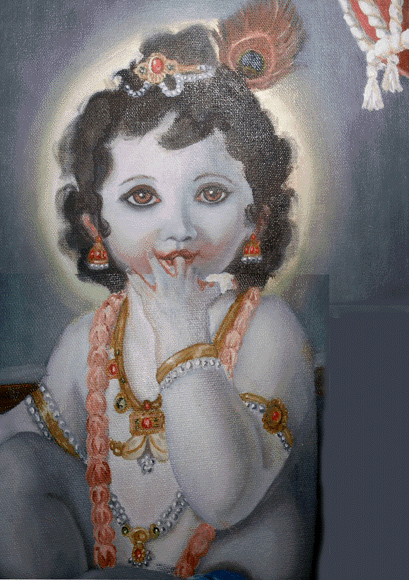
namo deva! damodarananta! visno!
Obeisances to You, O Deva! O Damodara! O Ananta! O Visnu! Sri Sri Damodarastakam - Text 6
prasida prabho! duhkha-jalabdhi-magnam
krpa-drsti-vrstyati-dinam batanu-
grhanesa! mam ajnam edhy aksi-drsyah
O Prabhu! Be pleased with me. I am sinking deeply into the ocean of tribulations
Shower the rain of Your merciful glance upon me who am so pitifully fallen
Alas! Kindly exhibit Your favour and deliver me O Isa! I am totally ignorant
Please become visible to my eyes
He prabho - means he madiya isvara, O my controller! (Offering You my obeisances, I beg) prasida - this word indicates prasadam, or be pleased with me and show Your mercy. (The reason for praying is) I am duhkha-jalabdhi-magnam - immersed in the ocean of misery. Specifically, the word duhkha (pain, misery, distress) indicates either the agony of repeated birth and death in the samsarika material world, or else the torment of not seeing You (resulting in feelings of ocean-like infinite desolation). Jalam - (meaning net, illusion, deception), and abdhih (ocean) denotes the extreme vastness - (By the force of my own karma) I am thus magnam (submerged). (I am tortured by all these harsh afflictions); therefore I am ati-dinam - very distressed.
Or else, another meaning of the word ati-dinam is - I am completely bereft of the association of saintly persons, and consequently without their assistance I am extremely fallen. Or else, yet another meaning is - (due to not seeing You) I am just like a living dead man. In this regard, I am also ajnam - I am particularly ignorant about how to resolve this problem. Then krpaya drsti-vrstya - showing Your own mercy, please shower me with Your nectar-laden glances - anugrhana - thereby uplifting me and once more enthusing me with life. This alone is the purport of the prayer. Then aksi-drsyo-edhi - please become visible before my eyes.
Prayers are usually made according to the sequence in which this one is prayed; as such it is not appropriate in this case to first mention the boon that is being requested, due to its nature of being the topmost of rarely attained benedictions.
The glory of attaining the direct vision of the Lord (saksat-darsana) within the mind is explained very logically by the personal associates of the Lord (sri bhagavat parsada) in the Brhad Bhagavatamrta, Uttara Khanda 3.179-182 *please see Appendix C, page 27* from this passage one may gain specific knowledge of these topics.
(Now the devotional kirtana of the Lord's names, used to address Him at the beginning of the mula-sloka, will be explained:) In this sixth verse the word deva indicates he divya rupa - O Lord of divine beauty! This beauty is the cause for desiring His darsana. The address of damodara intimates specifically that He is glorified for His excellence of bhakta-vatsalya, or affection for His devotees (up to the point of allowing them to bind Him around the waist). Therefore I will be qualified only by bhakti to see Him with my own eyes. He Who has no end (Whose mercy has no limits) is addressed as ananta. Therefore He will certainly shower His glance of mercy and thus favour me. The address prabhu connotes he acintya-ananta-adbhuta-maha-sakti-yukta - O You Who are endowed with inconceivable, limitless, astonishingly grand potency! Therefore You Who cannot be perceived by the senses can only become visible to my eyes by dint of this same inconceivable sakti of Yours. Addressing Him as isa suggests - he parama-svatantra - O You Who are supremely independent! In showing Your favour even to unfit souls, You are dependent on no one else. And moreover, the address visnu means he sarva-vyapaka - O You Who are all-pervading! Furthermore, it means - O You Who are fond of entering into Vrndavana's secluded caves and bower-cottages! Praying like this indicates that it is not difficult for Him to come before one's eyes; He does not have to labour hard to come from a distance.
(Some additional interpretations of the above-mentioned forms of address are now given:) Or else, he ananta means that He is aparicchinna or continuously existent without interval or separation. The address of visnu means He is sarva-vyapin or living everywhere. Therefore, he damodara proclaims Him thus - under the sway of His own parama-vatsalya-visesa or supremely affectionate attribute, there is absolutely nothing that He cannot do. The purport of the other words used for addressing Him may also be understood in terms of these expanded indications.
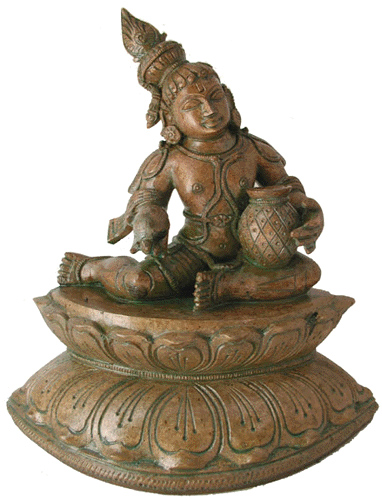
kuveratmajau baddha-murtyaiva yad-vat
O Damodara! Although You were bound to the mortar with ropes tied by mother YasodaSri Sri Damodarastakam - Text 7
tvaya mocitau bhakti-bhajau krtau ca
tatha prema-bhaktim svakam me prayaccha
na mokse graho me 'sti damodareha
You mercifully liberated the sons of Kuvera who were cursed by Narada Muni to stand as trees and You gifted them with Your own devotional service
Therefore please also bestow upon me Your own prema-bhakti in the most profuse way
This is my exclusive longing - I have no desire to any other type of liberation
Holding an apprehension like this, which perpetually brings the Lord under one's sway, is a feature of prema-bhakti - which is the one and only means of maintaining such a condition. This being declared the case, then how could it possibly be accomplished by such an utmost offender like me? The answer to this concern is that Sri Bhagavan's quality of bhakta-vatsalya (affection for His devotees) makes the impossible quite possible. In order to resolve this for certain, the proposal of moksa is again rejected here in the seventh verse beginning with kuveratmajau, where the prayer is made purely for attaining prema-bhakti.
The words baddha-murtya indicate that His sri vigraha (divine bodily form) was bound with ropes tied to the grinding mortar by Sri Yasoda; by that sri vigraha (He liberated the two sons of Kuvera). Thus by His dragging the mortar between (the two trees known as yamalarjuna) Bhagavan personally demonstrates the supreme fortune that comes in the form of saksat-darsana (seeing His form), personally touching His form, and so forth, which are integral attributes of His supremely beautiful pastimes. (Even though He Himself was tied up, now it is described how he liberated Nalakuvara and Manigriva:) The word mocitau denotes that they were liberated not just from the curse of Sri Narada, but from samsara (the material world) as well; they were not awarded with kevalam or impersonal liberation of merging into His all-pervading effulgence, but it is definitely stated that they were gifted with prema-bhakti. These two boys are described as bhakti-bhajau - they took shelter of bhakti as the supreme goal. Those who cannot give up the shelter of devotion in any way, shape or form are called bhakti-bhajam. (Krsna personally transformed them in this way). Thus it is the intention of the author to specifically declare that not only were they liberated, but that they were also awarded with prema-bhakti. In this regard, the Lord has declared to these two boys in the Bhagavatam (10.10.42):
“The sprout of prema for Me, which was your most supremely cherished goal, has now fully arisen in both of you. From this ecstatic mood, you will never take birth in the material world again.”
(Srila Sanatana Gosvami has elucidated upon this verse in his own commentary on the Bhagavatam). The purport is - The word vam (“You two”) indicates that Lord Krsna was addressing the two boys thusly: “The most desired thing you have prayed for is parama-bhava and you both have fully developed this prema for Me. Therefore you will never again experience bhava, the repeated birth and death in the material world, nor will you feel the misery of samsara even while living here.”
Then, he damodara! tatha - just like that - svakam - the exclusive shelter (asraya) of Your own lotus feet, or else - the exclusive objective (visaya) of such a beautiful form as Yours; namely prema-bhakti - me - unto me - prayaccha - please bestow it unto me in the most lavish way. (yaccha means “please give” and the prefix pra indicates prakarsena or “with profusion or intensity”).
Verily, it is just like Lord Sri Krsna is saying, “O he! Why are you so enthusiastic for prema-bhakti? Just accept liberation like the two sons of Kuvera, whereby the miseries of birth and death in the material world are finished.” To that, the answer remains the same - neti - no, thank you. Other than iha, this goal named prema-bhakti - na mokse graho me asti damodara - I have no eagerness for any other type of liberation, O Damodara! The purport of this is: one may think, “If the samsara is destroyed by engaging in prema-bhakti, let it be.” Or, “If prema-bhakti doesn't destroy the samsara, then let me not develop it.” I truly have no inclination for either mentality. The confidential mood is thus - if a cintamani lies in the palm of your hand, then all activities you undertake will be perfect; therefore what is the value of grasping a tiny, insignificant thing (like moksa)?
Or else, the phrase he damodara! prema-bhaktim svakam me prayaccha means - this Bhagavan's belly is bound with ropes, so from Him one prays for prema-bhakti in order to perpetually bind His belly; the eagerness for this reciprocation makes it actually possible. Apprehending such, the prayer continues (na mokse grahah, etc.), wherein the alarmed devotee offers - “Do I not have eagerness for You to become liberated from the ropes?” The purport is: “Yes, I certainly care.” This is precisely the meaning. But all I want from You (in Your bound up form) is that You bestow my most cherished benediction of prema bhakti.
Or else,, yet another meaning is - the word iha indicates “please bestow prema-bhakti here in Vrndavana” - this intention also follows. To interpret further,, one prays thus because Sri Vrndavana is the exclusive agent for the arising of prema-bhakti's unique happiness, also, only in Vrndavana Sri Krsna especially appears; also, the attributes of His saksat-darsana are found there in that form) with His belly bound); and further, one prays for perpetual residence in Vrndavana because only there does Sri Bhagavan desire to especially manifest as the enjoyer of the forest - Vrndavana-Vihari. All this is additionally evidence. Further details of these topics could be ascertained as we have been doing herein.
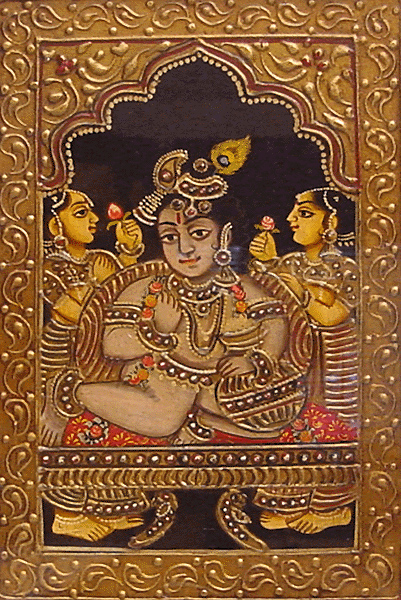
namas te 'stu damne sphurad dipti-dhamne
O Lord Damodara! Sri Sri Damodarastakam - Text 8
tvadiyodarayatha visvasya dhamne
namo radhikayai tvadiya priyayai
namo 'nanta-lilaya devaya tubhyam
I offer my obeisances unto the exalted rope binding Your waist which is the source of splendrously brilliant effulgence
I offer my obeisances unto Your belly which is the support of the entire universe
I offer my obeisances unto Radhika, Your dearmost beloved
And I offer my obeisances unto Your wondrous, uncommon pastimes
After that, tvadiyaya udaraya namo 'stu - I bow to Your belly. The reason for this is because while bound with ropes, You especially manifest the beauty and other qualities of Your belly as well as the glorious characteristics of vatsalya-lila and other pastimes. What is that belly like? It is stated visvasya dhama - that belly is the support for all the universes in creation, including all the stationary and moving beings contained therein. From the lotus navel on His abdomen has sprouted a gigantic lotus flower that sustains the fourteen worlds. Additionally, (during His childhood pastimes in Vrndavana) He bodily displayed the visva-rupa or universal form to His mother on two occasions. This is another indication. Therefore, in such a pastime of binding Him by the waist, mother Yasoda bound up the whole universe, indeed, she brought the entire creation under her control. This is the proclamation.
It is never possible to factually bind the (all-pervading, limitlessly potent) Lord, Who is Isa (the supreme controller), but He willingly accepts binding as an attribute of His superexcellent affection for His devotees (bhakta-vatsalya-visesa). And by that acceptance of binding we are informed that such pastimes are imperceptible to all the logic and reasoning available within all the material universes. This is an intimation of His aisvarya-visesa or attributes of majesty.
The reason for offering obeisances first unto the rope (dama) and then unto the Lord's belly (udara) is - because the rope is situated upon His belly. Or furthermore, to indicate the ascending superiority in the significance of different things, (respects are first offered to the rope, then to His belly).
Now, namo radhikayai - obeisances are offered unto His beloved, Bhagavati Sri Radhika. This is done in order to show that the mercy of His beloved enables one to fully attain the desire objective - including objectives that are even beyond the range of desire. By offering obeisances unto Sri Radhika, it is implied that obeisances are also being offered unto all the gopis. Or else, since Sri Radhika is the foremost of them all, obeisances are offered only unto Her.
The word radhika is used here to denote the attributes and excellence of one who is always engaged in Sri Bhagavan's aradhana or worship (arranging only for His pleasure); this is the purpose of using Her specific name “Radhika” in this text. Therefore - tvadiya-priyayaih - obeisances unto Your beloved. Or else, this name “Radhika” indicates rudhi (in grammatical terms, it is capable of conveying a meaning not supported by derivation). Therefore, regardless of Her aradhana or worship of You, She is still Your eternally dearmost beloved (nitya-priya). In this connection also, the word tvadiya indicates that not only is She dear to Yourself, but to all Your other devotees as well; what more, then, could be said about how dear She is to You? Additionally, this statement implies that You are also Her nitya-priya (eternally dear beloved). By such the excellence of Sri Radhika's love for Sri Krsna (prema-visesa) is suggested. This the words priyayaih namah in this verse can either mean - my obeisances unto You, Radhika's beloved; or, my obeisances unto Radhika, Your beloved. Whoever is beloved to You, such a person is certainly worshipable for the entire universe. Therefore, since Radhika is Your own dearmost beloved, namo 'stu - I bow before Her.
And finally at the conclusion of the prayer, the author desires to describe the supreme superexcellence of the rasa-lila and other transcendental pastimes that Lord Sri Krsna performs with Sri Radhika, but since these are the topmost of confidential topics, they are not mentioned directly. The logic of madhurena samapayet - “all undertakings should be completed sweetly” - applies here. Therefore such confidential pastimes are referred to only by a mere dint as they are offered obeisances with the words namo 'nanta-lilaya (obeisances unto Your limitless pastimes).
The word devaya indicates that obeisances are offered unto Bhagavan Who is lokottara - supernatural, divine, transcendental. With this it is intimated that by Damodara Krsna's divinely supernatural quality, then all the lilas performed by Him are also similarly transcendental. Or else, it could also be interpreted to mean - my obeisances unto You Who are continuously engaged in pastimes along with Sri Radhika. Therefore, ananta-lilaya tubhyam namah - I offer my respectful obeisances unto You Who are thus performing limitless pastimes. By the words ananta-lila, it is suggested to include all the pastimes associated with the realm of Gokula Vrndavana. I offer my obeisances unto all those lilas, such a mood is most certainly expressed in this verse.
![[BVML Home Page]](../grfx/bml_logo.gif)
